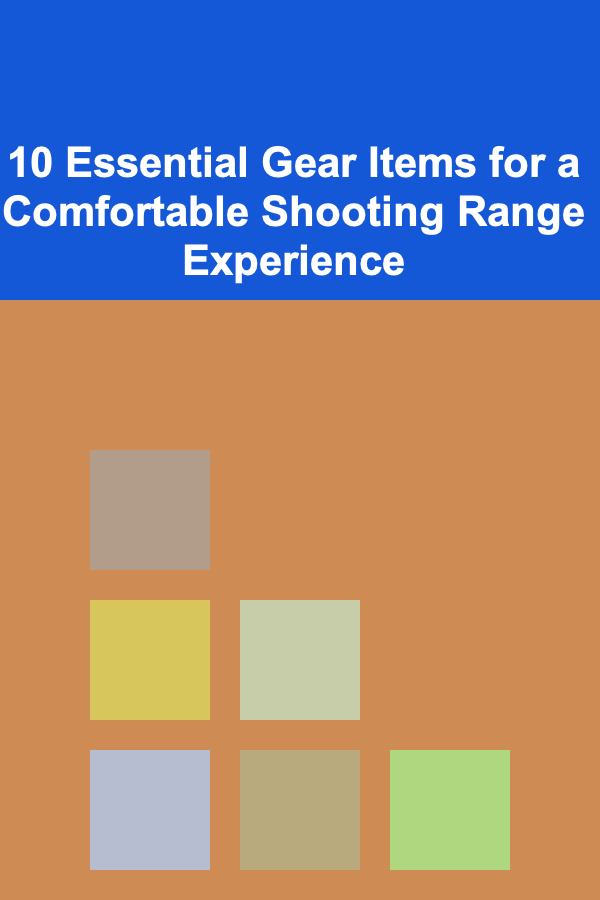
10 Essential Gear Items for a Comfortable Shooting Range Experience
ebook include PDF & Audio bundle (Micro Guide)
$12.99$6.99
Limited Time Offer! Order within the next:

Shooting ranges are places where enthusiasts can hone their skills, test new firearms, and enjoy a thrilling experience. Whether you're a seasoned marksman or a first-time shooter, the right gear can significantly enhance your comfort and performance. The following is a comprehensive list of the 10 essential gear items every shooter should have for a comfortable and safe shooting range experience. Each item is crucial for safety, comfort, and overall enjoyment, ensuring you get the most out of your time at the range.
Ear Protection: Protecting Your Hearing
When you're at a shooting range, especially in an indoor environment, the sound levels can be dangerously high. Gunshots are loud enough to cause immediate hearing damage. A good pair of ear protection is essential for both casual shooters and professionals.
Types of Ear Protection:
- Earplugs: Compact, portable, and easy to use, earplugs are an excellent option for shooters who prefer lightweight protection. Some earplugs are designed to block out specific frequencies, offering better sound filtering.
- Earmuffs: These provide more coverage and often feature noise-canceling technology, ensuring better protection for your ears. Earmuffs are more comfortable for extended sessions, as they can provide a more complete seal and are typically more effective at reducing sound.
Features to Look For:
- Noise Reduction Rating (NRR): The higher the NRR, the more effective the ear protection will be. Look for earplugs or earmuffs with an NRR of at least 25-30 dB for maximum protection.
- Comfort: Consider padded earmuffs for long shooting sessions, or look for ergonomically designed earplugs for a snug fit.
Eye Protection: Shielding Your Eyes
Eye protection is another critical component of shooting range gear. With the potential for debris, hot shells, or even malfunctioning equipment, keeping your eyes safe is non-negotiable.
Types of Eye Protection:
- Safety Glasses: The most common type of eye protection at shooting ranges, safety glasses are designed to protect your eyes from flying debris and impacts. They're made from durable materials like polycarbonate, which is highly resistant to shattering.
- Wrap-Around Glasses: These provide extra protection by covering the sides of your eyes, offering a more complete shield against particles and fragments that could fly from multiple angles.
Features to Look For:
- Anti-Fog Lenses: Consider glasses with anti-fog lenses to ensure clarity during extended sessions.
- UV Protection: If you're shooting outdoors, UV protection is essential to prevent damage from prolonged sun exposure.
Shooting Gloves: Comfort and Protection for Your Hands
Shooting gloves are not only about comfort---they also provide protection. Handling firearms can be physically demanding, especially for extended periods. Gloves protect your hands from blisters and provide extra grip for better control.
Types of Shooting Gloves:
- Full-Finger Gloves: These gloves provide complete coverage and protection, making them ideal for colder weather or when you need full dexterity with your fingers.
- Fingerless Gloves: For those who require maximum tactile feedback while shooting, fingerless gloves allow for better grip and control over the weapon, while still offering hand protection.
Features to Look For:
- Grip: Gloves should be made with materials like rubberized or leather palms to ensure you maintain a solid grip on the firearm, especially in sweaty or cold conditions.
- Breathability: Choose gloves that allow moisture to escape, keeping your hands dry and comfortable throughout your shooting session.
Proper Clothing: Comfort and Mobility
The right clothing can make a huge difference in your shooting experience. You want to ensure you are comfortable, able to move freely, and properly shielded from any potential hazards.
Key Considerations:
- Long Sleeves and Pants: Opt for long sleeves and pants to protect your skin from hot brass casings, debris, and potential recoil injuries. Light, breathable fabrics are ideal for warmer weather, while heavier clothing can be used for colder conditions.
- Moisture-Wicking Fabrics: These fabrics help keep you dry by drawing sweat away from your body. A comfortable, dry shooter is a focused and safe shooter.
- Proper Footwear: Sturdy footwear, such as tactical boots or shoes, provides both comfort and protection. It's important to have shoes with good traction to maintain stability when shooting.
Range Bag: Keeping Your Gear Organized
A good range bag is essential for carrying all your equipment and keeping it organized. You need a bag that offers compartments for each item, protecting your gear while ensuring everything is easy to access.
Features to Look For:
- Multiple Compartments: A range bag should have dedicated sections for your firearms, ammunition, ear protection, eye protection, and other essential items.
- Durability: Choose a bag made from durable, weather-resistant material to withstand the demands of the shooting range.
- Comfortable Straps: Ensure the bag is easy to carry, whether over your shoulder or in hand, with adjustable, padded straps.
Ammunition: The Fuel for Your Firearm
Having the correct ammunition for your firearm is, of course, crucial for any shooting activity. It's important to carry the right caliber for your weapon, and it's always wise to have extra rounds on hand in case your session lasts longer than expected.
Types of Ammunition:
- Full Metal Jacket (FMJ): This is a common type of ammunition used for target practice. FMJ rounds are made of a lead core surrounded by a metal shell and are typically inexpensive.
- Hollow Point: These rounds expand upon impact and are often used for self-defense purposes.
Key Considerations:
- Quality: Ensure that your ammunition is of high quality to avoid any misfires or malfunctions during your shooting session.
- Storage: Store your ammunition in a cool, dry place to prevent degradation and maintain optimal performance.
Firearm Maintenance Kit: Keeping Your Gun in Top Condition
Regular maintenance is essential for keeping your firearms in safe, working order. A good firearm maintenance kit allows you to clean and maintain your weapon between uses, which can enhance its performance and lifespan.
Key Items in a Firearm Maintenance Kit:
- Cleaning Rods and Brushes: Used to remove residue from the barrel, preventing build-up that could affect performance.
- Cleaning Patches: For applying cleaning solvents and oils to ensure the barrel is free of dirt and grime.
- Lubricant: Regular lubrication helps keep the moving parts of your firearm in good condition and functioning smoothly.
Targets: Essential for Practice and Accuracy
Without targets, shooting practice is simply not complete. Whether you're working on precision or improving your speed, having the right targets is key to tracking your progress.
Types of Targets:
- Paper Targets: These are the most common and come in a variety of designs, from basic bullseyes to more complex silhouettes.
- Steel Targets: These are durable and offer immediate feedback when struck, making them ideal for outdoor shooting ranges.
Features to Look For:
- Durability: Choose targets that can withstand repeated impacts and last through multiple shooting sessions.
- Clear Markings: Opt for targets with clearly visible scoring zones to help you measure your accuracy.
Shooting Mat: Comfort on the Ground
If you're shooting from a prone position or simply want added comfort when sitting or kneeling on the ground, a shooting mat is a great addition to your gear.
Features to Look For:
- Padding: A thick, cushioned mat will protect your knees and elbows from rough surfaces while offering a stable shooting platform.
- Water-Resistant Materials: This feature is essential if you're shooting outdoors, as it prevents moisture from seeping into the mat and making you uncomfortable.
First Aid Kit: Safety First
While safety measures like ear and eye protection go a long way, accidents can happen. Having a well-stocked first aid kit ensures you're prepared for any minor injuries or emergencies.
Key Items in a First Aid Kit:
- Bandages: For small cuts or abrasions.
- Antiseptic Wipes: To clean wounds before bandaging them.
- A tourniquet or Hemostatic gauze: In case of more serious injuries, though it's always best to seek professional medical help immediately.
Conclusion
A shooting range can be an exciting and educational experience, but it's essential to be well-prepared. The 10 essential gear items listed above will ensure that you're not only safe but also comfortable and efficient during your time at the range. By investing in high-quality, reliable equipment, you can elevate your shooting experience and focus on improving your skills while maintaining the highest standards of safety and enjoyment.
Reading More From Our Other Websites
- [Star Gazing Tip 101] Romantic Constellations: Crafting the Perfect Star-Gazing Date Night
- [Paragliding Tip 101] Soaring Together: Highlights from This Year's International Paragliding Meet-Ups
- [Small Business 101] How to Build a Brand Story That Resonates with Millennial Small‑Biz Customers
- [Weaving Tip 101] DIY Guide: Creating Modern Geometric Weave Designs with Simple Tools
- [Home Rental Property 101] How to Write a Lease Agreement That Protects Your Interests as a Landlord
- [Paragliding Tip 101] Best Low‑Noise Paragliding Wings for Silent Soaring Over Nature Reserves
- [Tie-Dyeing Tip 101] The Ultimate Guide to Tie‑Dyeing Apparel as Thoughtful Handmade Presents
- [Personal Finance Management 101] How to Manage Subscriptions and Recurring Expenses
- [Home Security 101] How to Choose the Best Home Security Camera for Your Needs
- [Beachcombing Tip 101] Discovering Nature's Gems: Educational Beachcombing Adventures for Children

How to Build a Checklist for Improving Website Navigation for Accessibility
Read More
How to Organize Family Pets' Needs and Responsibilities
Read More
How to Use Mirrors to Make Your Home Look Bigger on a Budget
Read More
How To Understand Quantum Computing for Materials Engineering
Read More
How to Live a Virtuous Life: Exploring Aristotelian Ethics
Read MoreHow to Integrate Your Employee Attendance Tracker with Payroll
Read MoreOther Products

How to Build a Checklist for Improving Website Navigation for Accessibility
Read More
How to Organize Family Pets' Needs and Responsibilities
Read More
How to Use Mirrors to Make Your Home Look Bigger on a Budget
Read More
How To Understand Quantum Computing for Materials Engineering
Read More